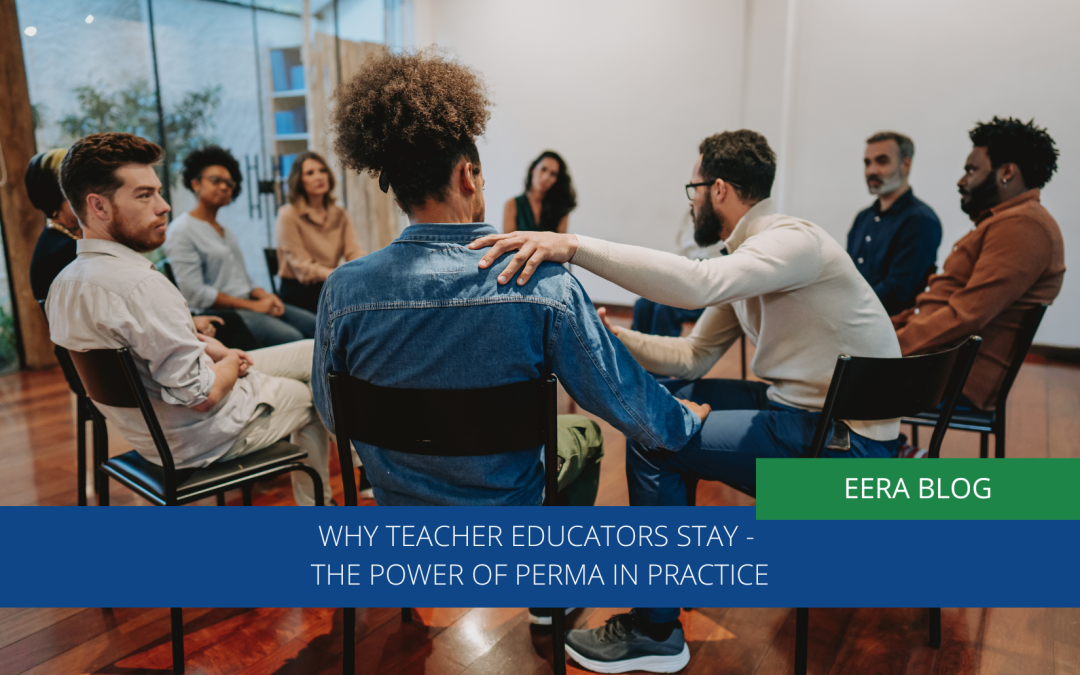Teacher educators (TEs) are a unique group of academics who balance the job’s usual paperwork, teaching, research, and service parts with the additional complex pressures of preparing and supervising student teachers on placement (and all that it entails). As such, they often feel bogged down by admin or overwhelmed by external pressures, including high-stakes inspections and re/accreditation procedures and the need to simultaneously publish high-impact research in quality peer-reviewed journals. Against the backdrop of reduced funding and resources across the sector, managing these many responsibilities will likely get harder before it gets better. This combination of push and pull factors leads to fatigue, stress, or burnout.
In our recent study of burnout in Teacher Educators in Ireland and the United Kingdom we found that many report moderate to high work-related burnout, which can have significant implications for their mental health and wellbeing (Fitzsimons & Smith, 2025). However, most teacher educators seem to persevere despite these challenges. So, what do they draw on to sustain them in this high-pressure profession?
The holding environment

A helpful way to understand where this resilience comes from is the concept of the “holding environment” (Winnicott, 1964; Kahn, 2001): a space that provides individuals with the emotional, psychological and social support needed to stay connected, engaged, and motivated. Though the term typically applies to familial or therapeutic relationships, workplaces represent another arena where individuals may experience setbacks and may need emotional support. There, the holding environment is about the relationships that make employees feel supported and valued. Put simply, it’s knowing that others ‘have your back’ and recognise your personal contributions and efforts.
The PERMA model – support and protection
In our research, we drew on Seligman’s (2018) famous PERMA model, which explores well-being through Positive Emotion, Engagement, Relationships, Meaning and Accomplishment, to understand the factors that support teacher educators in Ireland and the United Kingdom to remain resilient. Institutions instilling and nurturing these five elements can protect TEs and facilitate their growth. As asserted by Seligman, these intrinsic transformations cannot be inorganically fostered or summoned in response to demand, but rather require intentional activities, mindsets and habits that can require conscious effort. In other words, the environment should empower workers towards personal growth and it is not about mindset alone. Still, whilst infrastructure can facilitate environments where these outcomes are encouraged, the onus is also on the individual to actively flourish and reflects their uniqueness of engagement and meaning in the production of wellbeing. We think this ‘holding’ process happens in the following ways:
1. Positive Emotion
TEs in our study talked about the power of small, uplifting moments that carry them through the working week. These include sharing a laugh with a colleague (or having the ‘craic’ as we would say in Ireland), finding joy in teaching, or practicing gratitude. This positivity can act as an intrinsic buffer to the adverse events of the day, and this can help TEs recharge emotionally.
2. Engagement
Despite their pressures, many TEs spoke passionately about their role and the joy of working with brilliant young people. They described losing track of time while mentoring students, getting deeply involved in research, or their practice. As we know from Csikszentmihalyi this state of “flow” represents a sign of deep engagement and present moment focus. In a holding environment, individuals are supported to connect with the parts of their work that energise them. That sense of purpose can help to motivate them and possibly prevent against the factors that lead to burnout.
3. Relationships – Teamwork makes the dream work
Strong relationships are at the heart of TEs’ well-being. Colleagues who listen, share advice and show empathy can create a protective network that can shield each other from the stresses of the job. Our study showed that ITE settings with a collaborative, kind, and team-based culture gave educators the space to be open, to “sound off,” and to feel less alone. Indeed, knowing that you are not the only one to feel “spread thin”, and being able to draw on the wisdom and institutional memory of others is a highly valuable resource in the workplace. And this social infrastructure is the essence of a holding environment – support that helps carry the weight.
4. Meaning
The majority of TEs had previously been teachers or school leaders; many having a deep appreciation of the importance of their vocation and understanding the broader societal impact of their role. This sense of Meaning can act as the existential anchor that reminds teacher educators of their purpose and personal values, which are especially important during challenging times. TEs can feel lost at sea in the increasingly market-driven university setting when this ‘anchor’ isn’t stable, demonstrative of a lack of foundation grounding or sense of self within the larger infrastructure of the role.
5. Accomplishment
Feeling valued and making progress is an essential cornerstone of professional well-being. However, as we have outlined, TEs often face a frustrating reality – their teaching and mentoring work isn’t always valued in research-driven universities. For example:
- The hours of work spent preparing for the Ofsted (Office for Standards in Education, Children’s Services and Skills) or other ITE inspections.
- The late evening Zoom calls supporting student teachers who are facing a crisis in the classroom.
You won’t find these ‘duties’ on most appraisal forms or valued in promotion applications. As one TE told us, ‘How good a colleague you have been’ is not part of formal performance metrics. And yes, there may be prestigious awards for fulfilling certain aspects of academic duties, but those are awarded to only a few colleagues. So, informal recognition makes big difference; for example, a quiet thank you note from a student or genuine praise from colleagues can make TEs feel seen and appreciated. This validation is vital in a holding environment; it shows people what you do matters. You matter, and you are making a positive difference.
Formal support – What can institutions do to help?

You may have noticed we haven’t mentioned formal support for TEs. That is because this was barely mentioned in our study. Some participants highlighted well-being workshops, menopause clinics or yoga classes, but most TEs we spoke with said ‘I don’t have time’. Indeed, taking time out can get in the way of everything else. Managing work-life balance is paramount to offering a lifeline to staff who feel like they are treading water or barely staying afloat.
Our findings offer more than insight into occupational well-being—they present a clear call to action for institutions to create and facilitate supportive environments to allow TEs to thrive. TEs are highly motivated, values-driven professionals who care deeply about their students. This passion can lead to overwork and burnout, particularly in the absence of a secure holding environment.
There are a number of practical steps institutions can take:
1. Foster supportive relationships through mentorship, team-building and collaboration.
2. Recognise and appropriately reward the diverse nature of TEs’ work, not just research output.
4. The work of the TE can be emotionally exhausting – supporting not just students but colleagues as demonstrated – therefore, boundary setting should become the norm rather than the exception. Unless it is an emergency, it’s not an emergency and the ‘right to disconnect’ should be respected.
5. Although a ‘rage room‘ might be a good addition to most campuses, other more sanitised and evidenced based practices like mindfulness tools could prove helpful – however, these must be appropriately resourced and evaluated.
Our final thoughts
A holding environment is not built overnight. It’s created through daily acts of care, trust, and respect. For TEs, it’s the relationships, purpose, recognition, and shared positivity that “hold” them steady in an often-turbulent profession. By supporting the PERMA model and acknowledging its value, institutions can make the ITE workplace manageable and genuinely empowering.
Key Messages
- The occupational wellbeing of all involved in education is important; however, the wellbeing of one cohort, higher-education-based Teacher Educators, is often overlooked.
- Factors such as work overload, persistent policy change, external accountability/inspection measures and metricisation of their identity alongside resource constraints (do more with less) can lead to burnout.
- Attention needs to be paid to not only the risk factors but also the protective factors that keep Teacher Educators afloat.
- Seligman’s PERMA model provides one framework to explain what supports Teacher Educators to persist despite the ongoing pressures they face

Dr Sabrina Fitzsimons
Assistant Professor of Education
Sabrina is a lecturer in Initial Teacher Education and Co-Director of DCU CREATE—The Centre for Collaborative Research Across Teacher Education at Dublin City University, Ireland. Her research focuses on the occupational wellbeing and flourishing of educators, including higher education-based teacher educators, academics, school-based teachers, student teachers and other educators. She is a graduate member of the Psychological Society of Ireland and a Senior Fellow of the Advance HE.

Lee Boag
Lecturer, Robert Gordon University

David S. Smith
David S. Smith is a social psychologist. His research is focused on online identities, group membership and social cognition.
Fitzsimons, S., & Smith, D. S. (2025). “Just plough on and pretend it’s not happening”: Understanding burnout in teacher educators in Ireland and the United Kingdom. International Journal of Educational Research Open, 9, 100491. https://doi.org/10.1016/j.ijedro.2025.100491
Fitzsimons, S., Boag, L., & Smith, D. S. (2025). Understanding teacher educators’ quality of life: Insights from the PERMA model. Applied Research in Quality of Life. https://doi.org/10.1007/s11482-025-10435-z
Fitzsimons, S., & Smith, D. S. (2025). ‘Don’t do anything special for us coming’: the mental health impact of Ofsted inspections on teacher educators in England. Cambridge Journal of Education, 55(1), 93–111. https://doi.org/10.1080/0305764X.2025.2451280
Kahn, W. A. (2001). Holding Environments at Work. The Journal of Applied Behavioral Science, 37(3), 260-279. https://journals.sagepub.com/doi/10.1177/0021886301373001 .
Winnicott, D. W. (1964). The child, the family, and the outside world. Penguin Books https://www.penguin.co.uk/books/13592/the-child-the-family-and-the-outside-world-by-dw-winnicott/9780241455685

